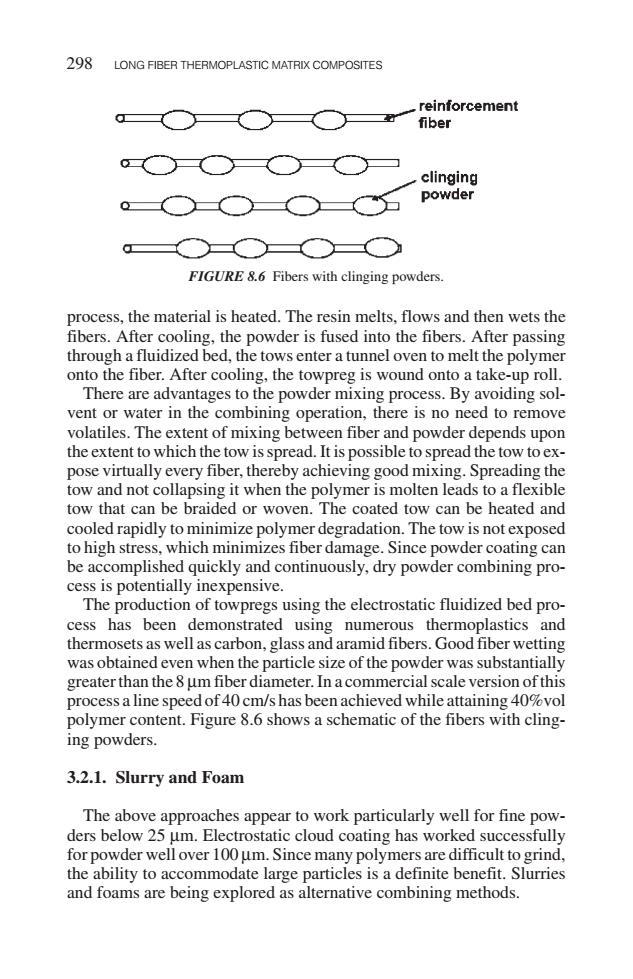正在加载图片...

298 LONG FIBER THERMOPLASTIC MATRIX COMPOSITES reinforcement fiber clinging powder FIGURE 8.6 Fibers with clinging powders. process,the material is heated.The resin melts,flows and then wets the fibers.After cooling,the powder is fused into the fibers.After passing through a fluidized bed,the tows enter a tunnel oven to melt the polymer onto the fiber.After cooling,the towpreg is wound onto a take-up roll. There are advantages to the powder mixing process.By avoiding sol- vent or water in the combining operation,there is no need to remove volatiles.The extent of mixing between fiber and powder depends upon the extent to which the tow is spread.It is possible to spread the tow to ex- pose virtually every fiber,thereby achieving good mixing.Spreading the tow and not collapsing it when the polymer is molten leads to a flexible tow that can be braided or woven.The coated tow can be heated and cooled rapidly to minimize polymer degradation.The tow is not exposed to high stress,which minimizes fiber damage.Since powder coating can be accomplished quickly and continuously,dry powder combining pro- cess is potentially inexpensive. The production of towpregs using the electrostatic fluidized bed pro- cess has been demonstrated using numerous thermoplastics and thermosets as well as carbon,glass and aramid fibers.Good fiber wetting was obtained even when the particle size of the powder was substantially greater than the 8 um fiber diameter.In a commercial scale version of this process a line speed of 40 cm/s has been achieved while attaining 40%vol polymer content.Figure 8.6 shows a schematic of the fibers with cling- ing powders. 3.2.1.Slurry and Foam The above approaches appear to work particularly well for fine pow- ders below 25 um.Electrostatic cloud coating has worked successfully for powder well over 100 um.Since many polymers are difficult to grind, the ability to accommodate large particles is a definite benefit.Slurries and foams are being explored as alternative combining methods.process, the material is heated. The resin melts, flows and then wets the fibers. After cooling, the powder is fused into the fibers. After passing through a fluidized bed, the tows enter a tunnel oven to melt the polymer onto the fiber. After cooling, the towpreg is wound onto a take-up roll. There are advantages to the powder mixing process. By avoiding solvent or water in the combining operation, there is no need to remove volatiles. The extent of mixing between fiber and powder depends upon the extent to which the tow is spread. It is possible to spread the tow to expose virtually every fiber, thereby achieving good mixing. Spreading the tow and not collapsing it when the polymer is molten leads to a flexible tow that can be braided or woven. The coated tow can be heated and cooled rapidly to minimize polymer degradation. The tow is not exposed to high stress, which minimizes fiber damage. Since powder coating can be accomplished quickly and continuously, dry powder combining process is potentially inexpensive. The production of towpregs using the electrostatic fluidized bed process has been demonstrated using numerous thermoplastics and thermosets as well as carbon, glass and aramid fibers. Good fiber wetting was obtained even when the particle size of the powder was substantially greater than the 8 µm fiber diameter. In a commercial scale version of this process a line speed of 40 cm/s has been achieved while attaining 40%vol polymer content. Figure 8.6 shows a schematic of the fibers with clinging powders. 3.2.1. Slurry and Foam The above approaches appear to work particularly well for fine powders below 25 µm. Electrostatic cloud coating has worked successfully for powder well over 100 µm. Since many polymers are difficult to grind, the ability to accommodate large particles is a definite benefit. Slurries and foams are being explored as alternative combining methods. 298 LONG FIBER THERMOPLASTIC MATRIX COMPOSITES FIGURE 8.6 Fibers with clinging powders